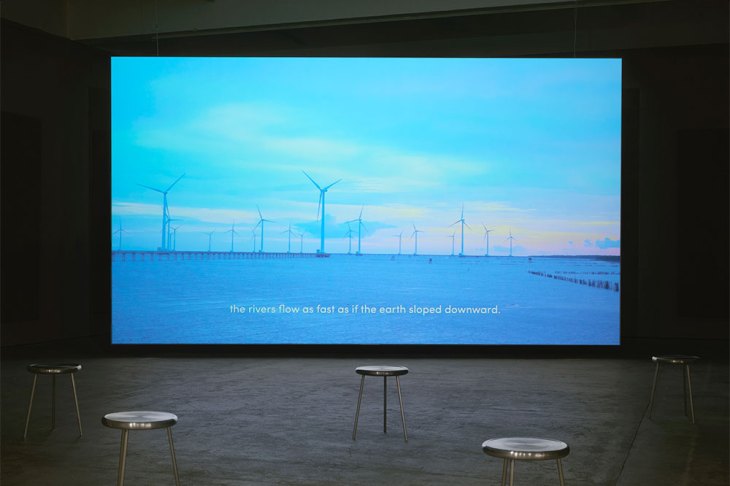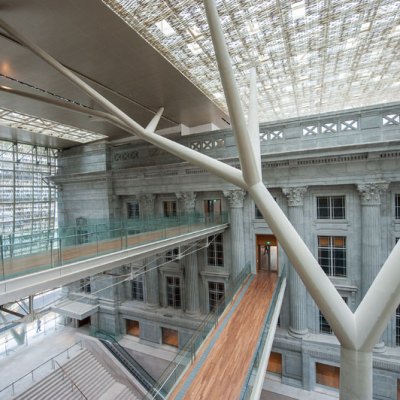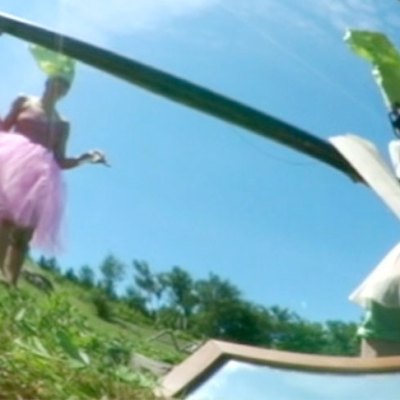In Rebecca Solnit’s recent memoir, Recollections of My Non-Existence (2020), the American author discusses the journey her work has taken towards ‘a more intimate, lyrical kind of writing, one where the spirit guiding the connections and trajectory was intuitive and associative rather than linear or logical’. It’s a perfect description for the wandering pathways fashioned by the Vietnamese artist Thao Nguyen Phan, whose exhibition at Chisenhale Gallery is her first solo show in the UK.
Like Solnit, Phan combines a politically charged ecological consciousness with an inquisitive, essayistic approach that brings together myths, allusions and quotations from a range of sources. The centrepiece of the show at Chisenhale, a 16-minute single-channel film entitled Becoming Alluvium (2019), begins with a series of questions from the great Bengali poet Rabindranath Tagore: ‘Why did the lamp go out?’, ‘Why did the flower fade?’, ‘Why did the stream dry up?’, ‘Why did the harp-string break?’ Like Tagore’s, Phan’s responses to these poetic puzzles suggest that a desire to resolve or master them only leads to further destruction.
Becoming Alluvium (2019), Thao Nguyen Phan. Installation view at Chisenhale Gallery, London, 2020. Photo: Andy Keate; courtesy the artist

Becoming Alluvium is, as the end credits inform us, ‘inspired by the beauty and suffering of the Mekong’ – the awe-inspiring river that runs for some 2,700 miles through Southeast Asia. Phan focuses on locations in South Vietnam, and structures her film via three sections or ‘reincarnations’, a term that reflects the river’s long spiritual associations and the artist’s own Buddhist upbringing.
The first section underlines the Mekong’s industrial power and economic value. Boats of all sizes and ages utilise its vast waters; food, other goods and workers are ferried around; steel bridges and tiny wooden crossings traverse its expanses. Though Phan has an eye for forms of transport and infrastructure, there remains a sense of calm and mystery amid all the commercial activity, an interplay of stillness and movement that reflects the river’s many moods. A voiceover recites extracts from Marguerite Duras’s autobiographical novel The Lover, which is set in French Indochina, as a young woman ponders the Mekong’s rhythms: ‘It flows quietly, without a sound, like blood in the body.’
Becoming Alluvium (2019), Thao Nguyen Phan. Installation view at Chisenhale Gallery, London, 2020. Photo: Andy Keate; courtesy the artist

The following section contrasts scenes of pleasure and waste surrounding the river. A family picnics by the shore, soggy rats are locked in a cage, a scavenger rummages through an enormous garbage pile. This latter image offers the most explicit evidence of Phan’s environmental concerns, accompanied by edited extracts from Italo Calvino’s Invisible Cities that suggest how an urban obsession with ‘new things’ inevitably leads to the expulsion and dumping of unwanted goods: ‘Perhaps a cataclysm will flatten this sordid mountain range.’ Yet, the film’s tone is never apocalyptic and the relationship between image and text is rarely direct. Instead, the work encourages associations to be made, offering tributaries of thought and currents of connection, without forcing a singular narrative. At times, this non-linear approach reminds me of John Akomfrah’s essay films, notably the ecologically focused Vertigo Sea (2015) and Purple (2017), while the dream-like stories of the film director Apichatpong Weerasethakul seem like another guiding spirit.
A retelling of an eerie Khmer folk tale guides the final ‘reincarnation’. We hear the story of a princess who begged for jewellery made from monsoon dew to be created for her wedding day. Her ‘vain demand’ cannot be satisfied by the kingdom’s most talented goldsmiths and she evaporates into the Mekong River – another soul flowing through its waters, another failed attempt to control and capture nature. Here, Phan switches from film footage to an animation featuring drawings and watercolours based on historical images, such as 19th-century engravings by the French artist, curator and explorer Louis Delaporte, who took part in an expedition along the river in 1866–68. The gentle fades between scenes employed in this section suggest an artist considering the long flow of history – transitions and connections between eras that evolve over extended periods – just as the alluvium invoked in the film’s title is a slow-building composite of different materials deposited and recycled over time.
Perpetual Brightness (2019–20), Thao Nguyen Phan. Installation view at Chisenhale Gallery, London, 2020. Photo: Andy Keate; courtesy the artist

Elsewhere in the exhibition is a series of paintings, entitled Perpetual Brightness (2019), made by Phan in collaboration with her husband, the artist Truong Cong Tung. A grouping of six watercolours on silk canvases stacked three by three features fantastical scenes populated by insects marching with musical instruments, children hosing rice fields with chemicals and a small boy cradling an Irrawaddy dolphin, a rare species that inhabits the Mekong River. The sense of otherworldliness is heightened by purple hews and hot pinks – a new folk-tale tradition coming in being. As Phan admits in a catalogue interview accompanying the exhibition, ‘Myth is probably the most beloved tool in my “tool kit”.’
Museums and galleries in the UK are closed from 5 November due to Covid-19. For more information on ‘Thao Nguyen Phan: Becoming Alluvium’ (scheduled to run until 6 December) visit the Chisenhale Gallery website.



